12 Important Features in a Center Console
Center console models are undoubtedly the sport utility vehicles of the boating world. A basic center console is like a Toyota FJ Cruiser, intended for rugged use in a variety of conditions and will most likely be used more for fishing than anything else.
More recently, high-performance center consoles have evolved into multi-engine boats with stepped bottom designs and cockpit accoutrements that remind us of a Range Rover or Cadillac Escalade as builders try to make them “family-friendly.”
Regardless of how the boat is going to be used, there are 12 key features that any buyer should be looking for.
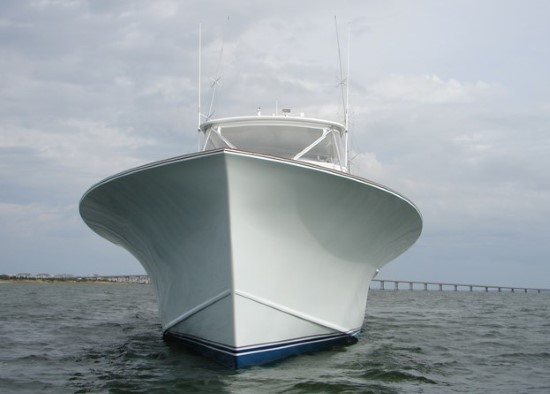
1. Hull Design
Because a center console could be used for myriad types of fishing, some bottom designs are better suited for certain pursuits. An angler who wants to spend most of his time offshore should look for a boat that has a deep deadrise at the transom – something on the order of 21 to 24-degrees – or, consider a catamaran.
The deep-V hull will cushion the shock of hitting waves at high speed and the boat will ride more comfortably as a result. The downside is that constant deadrise deep-V boats roll at trolling speeds and when at rest. Builders try to mitigate this tendency by adding wide chine flats, and reverse chines, which dampen rolling somewhat, but the warped bottom design helps the most.
Warped Hulls are Good. Most center consoles these days have “warped hulls” which simply means that they have a steep deadrise at the bow – on the order of 50 to 60 degrees – and the bottom “warps” at the midsections, flattening out aft to the transom where it might be 21 to 24 degrees, for example. “Constant deadrise” boats, such as the deep-V of the 1960s are pretty much a thing of the past. They are not as comfortable as are the new designs with a warped bottom and they are far more rolly.
Coastal anglers will find that boats offered for this purpose have bottoms with sharp entries that warp much more than their offshore sisters, with deadrises at the transom typically from 15 to 20-degrees. These boats don’t need a deeper-V hull because they are not going where the big waves are, and lower deadrise makes them much more stable for drift fishing, slow-speed operation.
Flats fishermen who primarily use light tackle in protected water that is generally smooth, would be happier with a mild “semi-V” that has far less deadrise and a shallower draft. These boats might have on the order of 11 to 15-degrees of deadrise at the transom. They are generally stable.
Those who enjoy drift fishing will want a boat designed with maximum at-rest stability in mind. A flatter bottom is more stable – except for a catamaran hull which is the most stable boat of all.
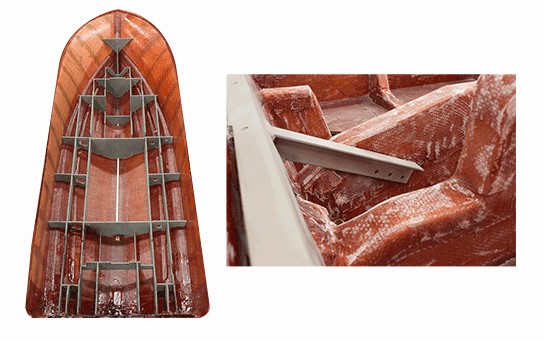
2. Construction
Regardless of the intended use, the boat should be built with stout stringers and a solidly cored transom. These days virtually all boats have their decks chemically bonded to the hulls with an adhesive that is actually stronger than the glass itself. The hull-to-deck joint are usually through-bolted with stainless-steel fasteners on the best-built boats. The joint should be capped by a rubrail that is substantial enough to take a bump at the dock, and the best builders use stainless steel here. All hardware should be 316L stainless steel.
Consumer Caveat. These days, major builders rarely have hull failures. More important are through-hull fittings, shut-off valves, and the quality of hoses and clamping – and the ability to easily reach them. Each boat will have to be inspected individually to assure that these details are done correctly. Low-priced boats are the ones most likely to be deficient in these areas.
Electrical. Likewise, the electrical system on any boat including center consoles is the most vulnerable to problems, particularly after a year of exposure to the harsh marine environment. Premium builders used tinned wiring, special waterproof connections, proper looms for keeping wiring from chafing, as well as having higher-quality components throughout the system. This is generally where buying a more expensive boat pays off after the first couple of years.
The electrical system is the hardest element for a consumer to inspect previous to purchase. We recommend looking at it wherever it is visible and if you find a rat’s nest of wires going every which way, we would move on. Inspect terminals: Are they coated, or do they have a protective plastic enclosed cover, or are they exposed?
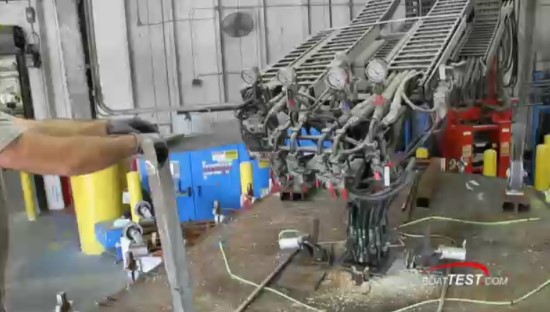
Flotation. The USCG requires that all powerboats with a 2-hp engine or larger that are 20’ (6.10 m) long or less “float level” when swamped. Boats over 20’ are not required to have any flotation. Most builders of boats over 20’ claim that they have “basic flotation” which simply means if the boat is swamped some part of it will be above the water.
We know of only three builders that will say in writing in their brochures and on their websites that their boats will float level if swamped.
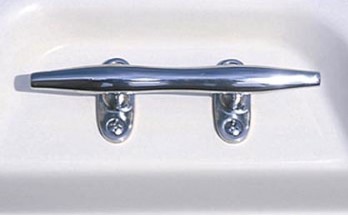
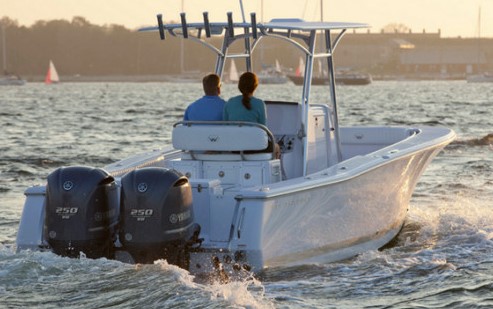
3. The Console
A person buying his first center console often overlooks the size of the console itself. Obviously, it’s going to depend on the size of the boat, but on any model 23’ (7.01 m) or longer, the console should be wide enough so that two people can stand behind it comfortably and be protected from on-rushing wind and spray. A properly designed boat will still have enough space for easy passage outboard of the console on each side – and that should be 20” or more.
Buyers should make sure they can easily see over the console in a standing position, as some are high.
Instrument/control panel. There should be sufficient panel space for electronics and each consumer must make his own judgment on this issue. Some owners want two large nav screens; others are satisfied with one large, multi-function screen. Today’s engine makers all have their own monitoring screens and a dedicated space must be available for them within easy line of sight.
Throttle and Shift Mounting. Most center console builders mount their engines' control sticks on an angle of 45-degrees or more – some nearly 80 degrees. The higher the angle, the less ergonomic is the design. We would like to see the base of the controls on an angle of no more than 20 degrees for best handling so that throttle settings can be fine-tuned easily. This issue has been mitigated recently by drive-by-wire controls.
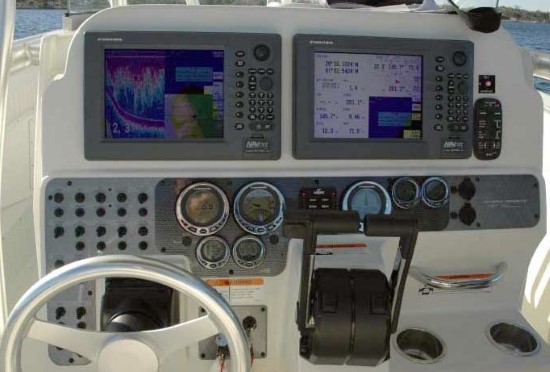
Position of the Steering Wheel. This is a detail that is incorrectly designed on a surprising number of boats. Some builders mount the steering wheel in the center of the console where two people are intended to sit, stand or lean. That means that the driver can’t stand directly behind the wheel, or that his companion must move to one side. The wheel and controls should be mounted to one side or the other, usually the port side to provide more space for the controls. Likewise, the compass should be mounted directly in front of the wheel’s hub, not in the center of the console.
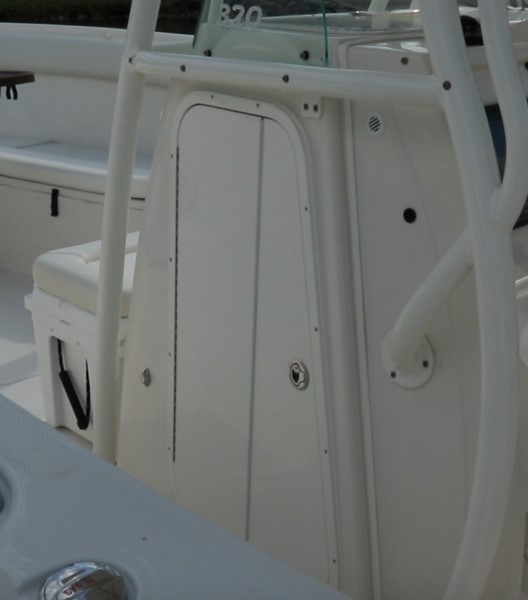
Console Entry Door. Most center-console models have a door on the port or starboard side that allow entry into the console. These doors are problematical as they are often hard to get through in order to enter the compartment. A few builders cut out the top of the console, creating a large hatch that makes entry easier. More recently, some builders have begun making entry hatches in the front of the console. These are both good solutions.
Head Compartment. Many have a portable head, pump-out model, or even an electric toilet in this compartment. This is a detail that makes the boats more “family friendly.” Be sure to check both standing and sitting headroom. Larger boats often have a sink with a shower wand so the compartment can be used as a wet head. The head compartment should be lockable as it is usually used for storage, as well.
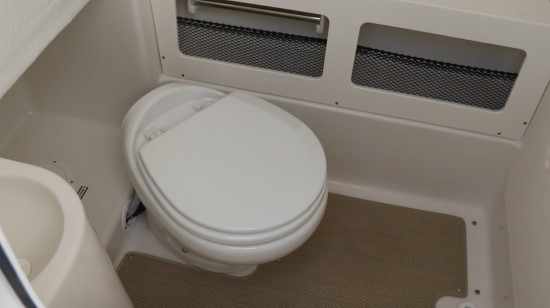
4. A T-top
In our opinion, every center console boat should have a T-top for protection from the sun. It serves the added advantages of protecting a drive and companion from the rain as well as the support structure upon which to hang a manner of things. They are usually optional equipment, so crank it into the price of the boat.
Bimini tops are not appropriate, unless you have no plans on fishing from the boat.
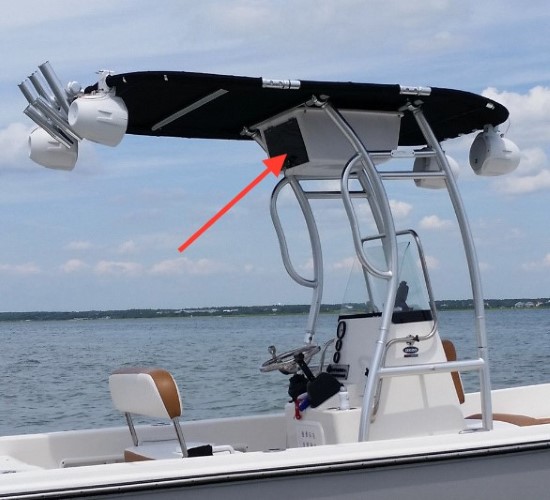
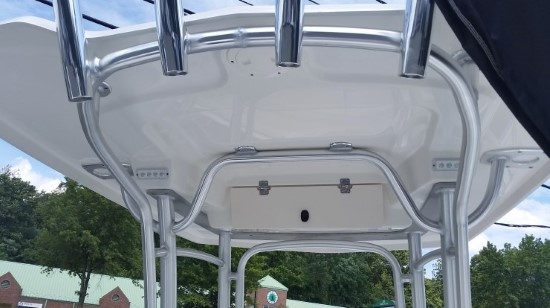
Aluminum T-top Supports. Because of the high Gs encountered by center consoles flying off waves at high speed, even supports holding a lightweight canvas top must have a robust diameter. This is fine except for two things: 1) Fabricators often obscure the driver's vision with the supports and cross members; 2) when these are screwed into the deck they invariably do so on the side decks around the center console thereby becoming a tripping hazard and reducing the clearance between themselves and bulwarks. They have the advantage of being relatively low cost.
Today, a number of premium builders have integrated the aluminum supports into the console itself, which looks far better, do not reduce visibility, nor do they reduce side deck clearance. Some of them have even integrated safety glass windshields into the supports.
Electronics Box -- Not! Both of the examples of T-tops on this have boxes overhead which are typically referred to as electronics boxes. We don’t recommend putting electronics there unless you are 7’ (2.13 m) tall or have a very long neck. We refer to these boxes which are usually lockable as storage boxes, and they are good for that.
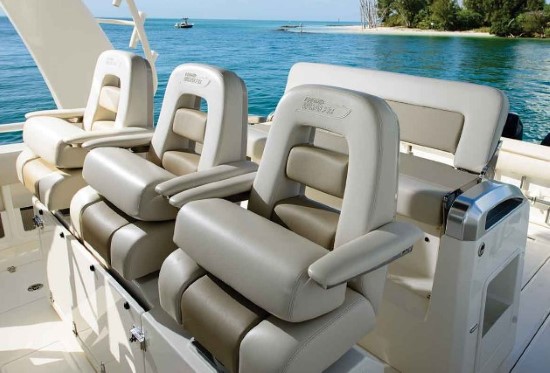
5. Seat/Leaning Post
Most fishing-focused center consoles these days will provide some type of seating in the stern, either flip-up jump seats or snap-down jump cushions on top of a livewell or storage compartment hatch. We really don’t recommend the latter arrangement because all seats should have seat backs for safety.
The helm can have anything from a basic leaning post to individual captain’s chairs with full-height backrests. In fact, premium builders are now constructing seats for center consoles that are every bit as comfortable, if not more so, than much-prized Stidd seats often found on gold-platers. So, seating runs the gamut at the helm, depending on cost.
Many boats have a bottom cushion and backrest on the front of the console, or on a cooler that is secured in front of the console. Longer lounges forward in the bow, just like what have been on bowrider sport boats for years are now being found on center consoles. The backrests are always removable for fishing. These backrests are considered a “family-friendly” amenity. It’s a small feature that enhances the boat’s comfort when it’s not used for fishing.
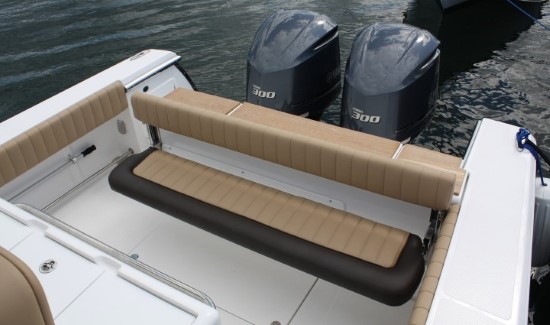
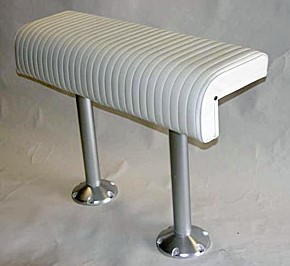
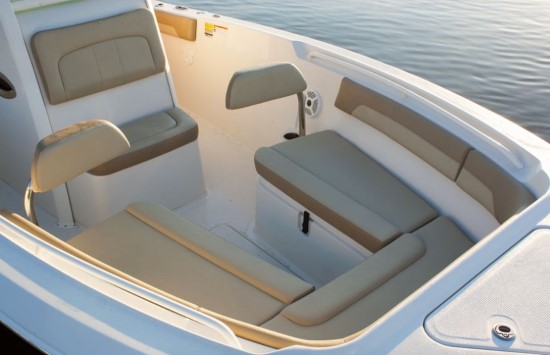
6. Big Fishboxes
Fishboxes must be adequate for the size of boat and for the kind of work the owner wants to do. Some center consoles have remarkably skimpy fish boxes, so don’t take this for granted. And, they must be insulated and self-draining or have pumps to drain them; and macerators are best to have plumbed into the system… We like fishboxes that drain overboard, but if they are equipped with pumps, they should be a diaphragm-type pump.
If there’s a bilge pump mounted in a fishbox, it’s an indicator that the manufacturer doesn’t know how to equip a boat for the rigors of offshore fishing. A bilge pump will clog with scales and slime in no time. If the boat isn’t used for fishing, an insulated compartment that drains overboard makes a great cooler or it can be used for storing wet items like towropes and wetsuits.
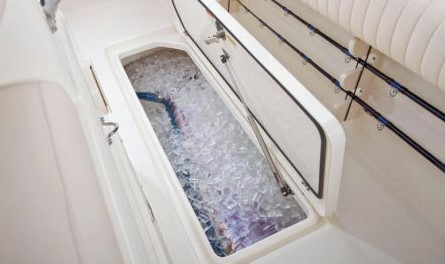
Lockable Storage. Whether it’s fishing rods, tackle boxes or watersports accessories, having a secure place to store them aboard is a great benefit. It keeps an owner from having to cart everything back and forth between home and the boat. We also prefer a locking glove box-style compartment somewhere on board for stashing things like car keys, a cell phone or a camera. Most boats also have racks in the gunwales for storing rods and other long items such as gaffs or boat hooks.
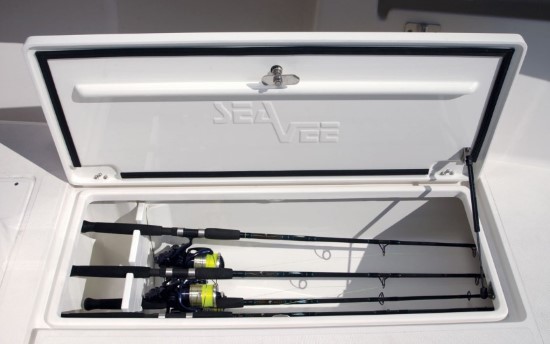
7. Sufficient Fuel Capacity
An angler is always looking for another hot spot and “It’s just a few miles away” or the kids just want to take one more tube run before heading home. The “1/3 Rule” is a good approach. Use a third of the fuel capacity to get to a destination and a third to get back with the final third in reserve just in case.
Fuel capacity is another area where there is quite a bit of diversity among center console builders, even those with boats in the same class. Fuel tankage has to do with a number of issues, including how the builder thinks most people will use the boat. If the boat won’t be used for runs to the canyons, but more for just coastal fishing, then the fuel capacity might be scaled back.
Also, room in the bottom of the boat and the boat’s trim are other issues. Smart skippers fuel the boat for each excursion, being careful not to be hauling around fuel that is not needed which only burns more fuel.
Two Fuel Systems. It should be noted that catamarans generally have two separate fuel tanks and separate fuel systems. This is a plus, because if gremlins get into one system, there is a fallback. Most monohulls don’t have this luxury.
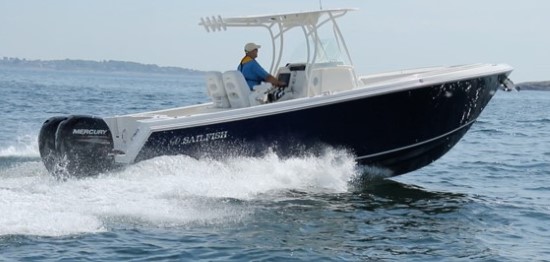
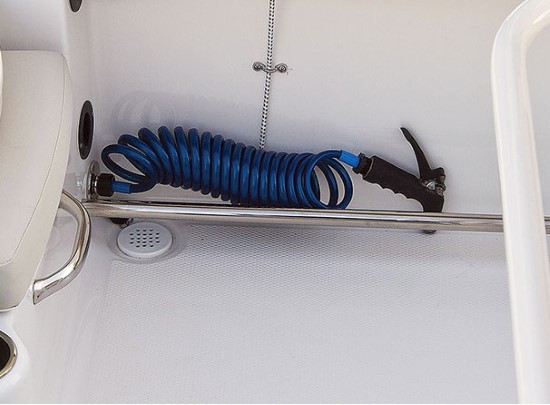
8. Raw Water Washdowns
Fishing means blood, chum, squashed baits and an overall mess that needs to be cleaned up quickly before the sun dries the gunk. A strong raw-water washdown system makes cleanup a breeze. Make sure the washdown system has its own pump. Combination livewell/washdown models rarely have the pressure to wash away the mess, especially if the livewell pump is running.
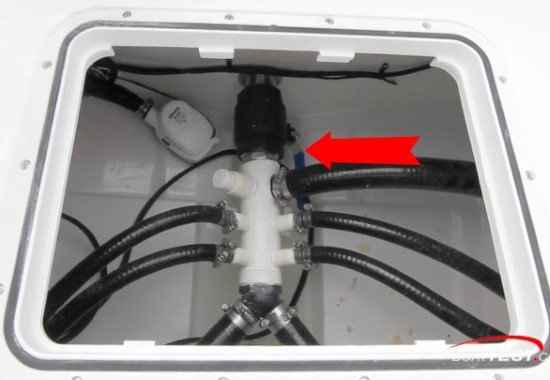
9. Seacocks and Ball Valves
Every hole in the bottom of any boat below the waterline when fully loaded should have a seacock or a ball valve so that water coming in can be stopped. But having a seacock or ball valve that can’t be reached is almost as bad as not having one in the first place. ABYC Standards require that there be a shut off device and that it be reachable, yet occasionally we run across a low-priced boat that does not have them. This important detail can’t be taken for granted by boat owners.
Check all through-hull fittings before buying and make sure they can be reached. Hoses should, of course, be double clamped.
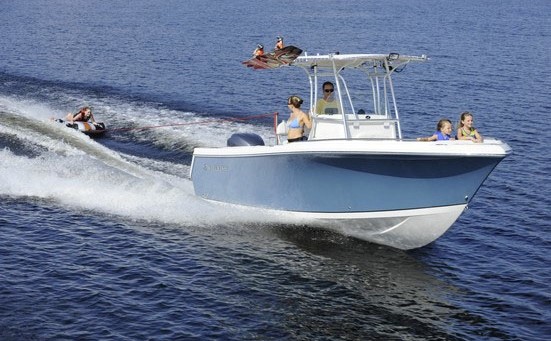
10. Transom Access
On larger boats, it’s nearly impossible to work a fish around the motors without a transom door that lets the angler step out onto the swim platform and outboard well. Most new designs have a door and at least a small walking surface ahead of the motors. New designs have more platform space here as builders try to make their center consoles more “family-friendly” and suitable for some casual towing sports.
Can You Reach the Ladder? The more platform space there is behind the transom, the easier it is to fight a fish or prep for watersports. The ABYC Standards also call for a reboarding ladder on all power boats that can be reached from the water. We occasionally see center consoles, even built by well-known brands, that have detached boarding ladders that can’t be reached from the water. Not only must boats have ladders that can be reached from the water, but they also must extend 22” below the waterline, according to ABYC Standards. This is why, increasingly, we are seeing four-step ladders, whereas before, even some premium boats have only 3-steps.
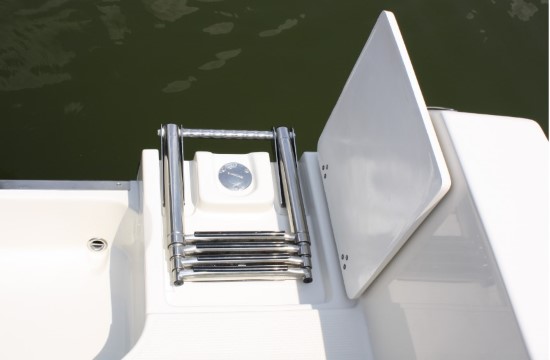
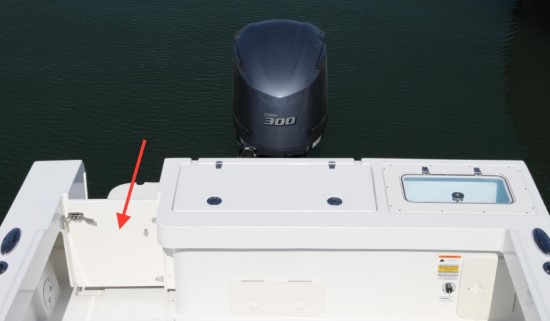
11. Dewatering System
Anyone venturing offshore in a center console must remember that it is an open boat. Open boats are – in adverse conditions – vulnerable to being flooded with green water. Once enough water enters any boat it is subject to the “free surface effect” of water moving to one side and capsizing the boat with its weight and the force of its movement. This does not happen often for a variety of reasons, but it can and does happen occasionally.
The 1” and 2” drains and even four 2” drains will not de-water a swamped boat fast enough to avoid the free surface effect from capsizing a boat. Bilge pumps are designed to pump rain water and slow leaks out of a boat, but nothing more. Only one thing can quickly dewater a swamped boat, and that is an open transom door, and forward movement. That is why we like to see them, and to see them opening out. With the boat moving forward, an open transom door can quickly dewater an open boat. In such a situation, time is of the essence.
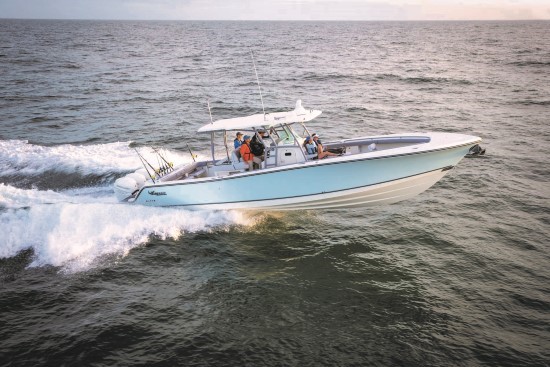
12. Freeboard
What is freeboard? It is the distance from the waterline to the lowest point of a boat’s coaming over which water can flow. For example, a boat that has a high bow that measures 36” from the deck to the water, but has a stern cap rail that is only 24” above the water, is said to have a freeboard of 24” – because that is the lowest point over which water may flow.
Builders design their boats and the freeboards of them to match the conditions for which the boat is built. Bay boats, flats boats, swamp prowlers and protected water boats have low freeboard because they don’t need high freeboard. It would be in the way and only adds needless cost and weight to the boat.
Coastal center consoles should have higher freeboard than bay boats because they are going to be in larger bodies of water and will occasionally be running inlets. They will be going fast in chop and wind that can send spray into the boat. Higher freeboard not only makes them safer, it also makes them dryer.
Offshore center consoles should have the highest freeboard of all because they will be out in bluewater and potentially operating in 4’ (1.22 m) to 6’ (1.83 m) seas or even more. In these conditions freeboard is more than just keeping the spray out, it is more importantly for keeping green water out, and passengers in.
Freeboard is particularly important for boats going offshore, and there is in the U.S. a standard for determining the height that freeboard should be. And, as you research boats, you will find a variation of as much as 20% to 30% from the lowest to the highest. Let your own local conditions and how and when you plan to use your boat and when, be your guide to how much freeboard is right for you and your family.